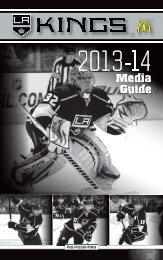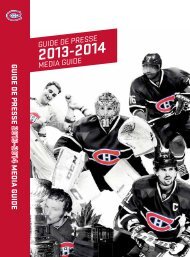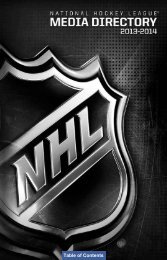2013-14 MEDIA GUIDE
new jersey devils 2013-14 media guide - New Jersey Devils PR
new jersey devils 2013-14 media guide - New Jersey Devils PR
- No tags were found...
You also want an ePaper? Increase the reach of your titles
YUMPU automatically turns print PDFs into web optimized ePapers that Google loves.
HOW TO FIGuRe…<br />
ASSIST: An assist is awarded to the player or players (maximum of two) who touched the puck<br />
prior to the goal, provided no defender plays or possesses the puck in between.<br />
GAME PLAYED: A player receives credit for playing in a game if: i) he steps on the ice during time<br />
played or; ii) serves any penalty.<br />
GAME-WINNING GOAL: After the final score has been determined, the goal which leaves the<br />
winning club one goal ahead of its opponent is the game-winning goal (example: if Team A beats<br />
Team B 8-3, the player scoring the fourth goal for Team A receives credit for the game-winning<br />
goal).<br />
GOAL: A goal is awarded to the last player on the scoring club to touch the puck prior to the puck<br />
entering the net.<br />
GOALS-AGAINST AVERAGE: Multiply goals allowed (GA) by 60 and divide by minutes played<br />
(MINS).<br />
GOALTENDER: A goaltender receives a “W” for a win in regulation, overtime or shootout; an “L” for<br />
a loss in regulation; or an “OT” for a loss in overtime or shootout.<br />
PENALTY-KILLING PERCENTAGE: Subtract total number of power-play goals allowed from total<br />
number of shorthanded situations to get total number of power-plays killed. Divide the total number<br />
of power-plays killed by the total number of shorthanded situations.<br />
PLUS-MINUS: A player receives a “plus” if he is on the ice when his club scores an even-strength<br />
or shorthand goal. He receives a “minus” if he is on the ice for an even-strength or shorthand goal<br />
scored by the opposing club. The difference in these numbers is considered the player’s plus-minus<br />
statistic.<br />
POWER-PLAY GOAL: A goal scored by a club while it has a manpower advantage due to an<br />
opponent’s penalty. Following are some examples of what is and is not considered a power-play<br />
goal:<br />
• if a club has an advantage on a minor penalty starting at 2:02 of the period and it scores at<br />
4:02, the goal is not a power-play goal.<br />
• if a club scores on a delayed penalty, the goal is not a power-play goal.<br />
• if a club has an advantage due to a five-minute major or match penalty, that club is always<br />
credited with having one more advantage than the number of power-play goals it scores<br />
during that advantage, because the penalty does not expire. A new advantage begins after<br />
each power-play goal. For example, if Team A scores three goals during a major penalty, it is<br />
credited with four advantages.<br />
• if a club is on a power-play for any length of time, it is considered to have had an advantage.<br />
• if a minor penalty is incurred by a club on a power-play due to a major penalty, a new<br />
advantage is given to that club when its minor penalty expires, provided the opponent’s major<br />
penalty is still in effect.<br />
POWER-PLAY PERCENTAGE: Total number of power-play goals divided by total number of<br />
power-play opportunities.<br />
SAVE PERCENTAGE: Subtract goals allowed (GA) from shots against (SA) to determine saves.<br />
Then divide saves by shots-against.<br />
SHOOTING PERCENTAGE: Divide the number of goals scored by the number of shots taken.<br />
SHORTHAND GOAL: A goal scored by a club while it is at a manpower disadvantage. The same<br />
cases apply for shorthand as for power-play goals, but in the opposite manner.<br />
SHOT ON GOAL: If a player shoots the puck with the intention of scoring and if that shot would<br />
have gone in the net had the goaltender not stopped it, the shot is recorded as a “shot on goal.”<br />
SHUTOUT: If two goaltenders combine for a shutout, neither receives credit for the shutout.<br />
Instead it is recorded as a club shutout.<br />
TENTHS OF A SECOND: If a penalty or goal occurs in the last minute, the time is rounded off to<br />
the previous second (ex: if a penalty is called with 12.4 seconds left in a period, the time is<br />
indicated as 19:47 and not 19:48.)<br />
<strong>2013</strong>-<strong>14</strong> NATIONAL HOCKEY LEAGUE ALIGNMENT<br />
On March <strong>14</strong>, <strong>2013</strong>, the National Hockey League's Board of Governors approved realignment and a<br />
division-based format for the Stanley Cup Playoffs, effective for the <strong>2013</strong>-<strong>14</strong> season. The<br />
realignment plan creates two eight-team divisions in the Eastern Conference and two seven-team<br />
divisions in the Western Conference.<br />
The new alignment will place several clubs in more geographically-appropriate groupings and will<br />
intensify already-fierce rivalries throughout the league. The new scheduling matrix will ensure that<br />
all 30 teams play in all 30 arenas at least once a season.<br />
WESTERN CONFERENCE<br />
Pacific<br />
Central<br />
Anaheim<br />
Chicago<br />
Calgary<br />
Colorado<br />
Edmonton<br />
Dallas<br />
Los Angeles Minnesota<br />
Phoenix<br />
Nashville<br />
San Jose<br />
St. Louis<br />
Vancouver<br />
Winnipeg<br />
NEW REGULAR-SEASON SCHEDULE MATRIX<br />
Western Conference (7-team divisions)<br />
Within conference (division): 29 games<br />
• 5 games vs. five teams AND 4 games vs.<br />
one team. Teams rotated on a yearly basis.<br />
Within conference (non-division): 21 games<br />
• 3 games vs. each team. Teams rotated on<br />
a yearly basis.<br />
(exception: 1 team from each div. plays 1<br />
less game inside div. & 1 more game inside<br />
conf. outside div.).<br />
Non-conference: 32 games<br />
• 2 games vs. each team<br />
EASTERN CONFERENCE<br />
Metropolitan Atlantic<br />
Carolina<br />
Boston<br />
Columbus<br />
Buffalo<br />
New Jersey Detroit<br />
NY Islanders Florida<br />
NY Rangers Montreal<br />
Philadelphia Ottawa<br />
Pittsburgh Tampa Bay o<br />
Washington Toronto<br />
Eastern Conference (8-team divisions)<br />
Within conference (division): 30 games<br />
• 5 games vs. two teams AND 4 games vs.<br />
five teams. Teams rotated on a yearly<br />
basis.<br />
Within conference (non-division): 24 games<br />
• 3 games vs. each team. Teams rotated on<br />
a yearly basis.<br />
Non-conference: 28 games<br />
• 2 games vs. each team.<br />
STANLEY CUP PLAYOFF FORMAT<br />
Playoff qualification will be primarily division-based, with the top three finishers in each division<br />
qualifying for the first 12 spots in the Stanley Cup Playoffs (and the first three "seeds" in each division).<br />
The two additional playoff spots in each conference, designated as "Wild Cards," will be awarded to<br />
the next two highest-placed finishers in each conference, ranked on the basis of regular-season<br />
points and regardless of division.<br />
"Seeding" of the Wild Card teams within each divisional playoff will be determined on the basis of<br />
regular-season points. The first-place finisher with the highest number of regular-season points in<br />
the conference will be matched against the Wild Card team with the lowest number of regularseason<br />
points, and the first-place finisher with the second-highest number of regular-season points<br />
in the conference matched against the Wild Card team with the second-lowest number of regularseason<br />
points.<br />
The playoffs will proceed as follows:<br />
• #1 vs. #4 / #2 vs. #3 – winners play each other for berth in conference championship.<br />
• Conference finals – two advancing teams in the West and two advancing teams in the East<br />
meet in conference championship.<br />
• Eastern and Western Conference Champions will meet in Stanley Cup Finals.<br />
The NHLPA has given its consent to play under this new alignment and playoff system for a<br />
minimum of three seasons, through the 2015-16 NHL season.<br />
nHL ALIGnmenT<br />
320<br />
COACHES RECORD: A coach receives a “W” for a win in regulation, overtime or shootout; an “L”<br />
for a loss in regulation; or an “OT” for a loss in overtime or shootout.<br />
** NOTE: No individual skater/goaltender statistics apply for the shootout<br />
321
















